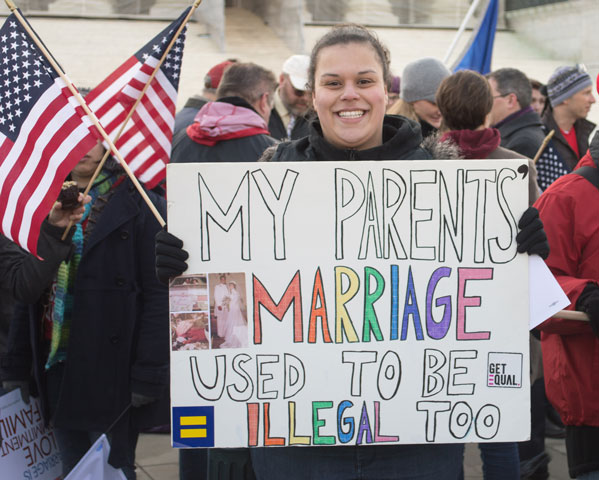
A supporter of marriage equality demonstrates in front of the U.S. Supreme Court in March 2013. (Dreamstime)
In June, upon returning from some much-needed time with family, I caught up with my email only to find a letter from our parish priest denouncing the Supreme Court's Obergefell v. Hodges decision that made same-sex marriage legal. He made two troubling claims: that the Obergefell decision overturned a "millennia of human wisdom" regarding marriage, and that church teaching is "unchanging."
As a practicing Catholic, a gender-queer person in a same-sex marriage of 24 years (by grace, not by institution), and as a trained and practicing historian, my mind quickly went from "But that is just not so" to "With so many similar claims being made on the part of our pastors, perhaps those of us who study history need to speak up."
It is critical that those of us within the church who know the long view of history share that long view with the faithful. That view reveals slow change in the civil status of marriage toward recognizing the dignity of women, as well as a slow change in church teaching toward recognizing the dignity of the human person.
Initially, in the U.S., the institution of marriage was rooted in social inequality. Historian Linda Kerber has noted that, with the exception of eliminating petit treason (treating the murder of a husband by his wife as regicide), "neither the government of the Articles of Confederation nor the federal government of the Constitution directly challenged the legal system of coverture."
Under coverture, Kerber as well as Nancy F. Cott and other women's historians point out, the institution of marriage stripped women of their basic civil and, at times, human rights: When a woman married, she lost her property rights, and her husband had the right to sign contracts on her behalf. State-sanctioned marriage was less about acknowledging the love bond between two adult persons than it was about maintaining white male property rights.
We can thank God that institutions do change, including those regarding human relationships. Beginning in the mid-19th century, an increasing number of states ruled that, through marriage, women did not lose their property rights. The Cable Act (1922) made it possible for an American woman to marry an "alien" without losing her citizenship. Marriage between white citizens and people of color was decriminalized with the Loving decision of 1967, and today men who abuse and/or rape their spouses can be prosecuted in a court of law.
These changes, where women are treated with dignity, have benefited our larger communities -- what we as Catholics refer to as the common good. Our most recent change, from the requirement that the adults entering into the marriage contract include one man and one woman, to a contract between two consenting adults, builds on this slow trend toward understanding marriage as based in love and mutuality, rather than in matters of race, power, control and property rights.
While changes to the institution of marriage as a state institution have slowly recognized the dignity of women as human persons, changes in church teachings and practices regarding human dignity and the common good have been even slower. Perhaps this explains assertions that there is no change at all.
Yet as members of a church that has been developing for 2,000 years, we must remember to take the long view of history. In the late Middle Ages and the early Renaissance, the institutional church "relaxed" heretics to the state to be burned. We no longer do this. Burning heretics, we have come to realize, is against the dignity of the human person and is not a good and holy thing to do.
But there are more recent changes in our church's approach to human dignity that also merit mention. While these changes took much longer to take effect, their roots were equally deep, if not deeper, than the tradition of relaxing heretics to the state.
There is the teaching regarding unbaptized infants, who, according to Augustine, were condemned to hell. This teaching began to change in the 12th century (700 years later) when Abelard agreed that unbaptized infants would not share in the beatific vision, but also argued that they would not be subjected to other eternal punishments.
Because of these teachings, which held for yet another 800 years, children who died without the sacrament of baptism did not receive Christian burial until the 1960s. As theologian Francis A. Sullivan notes, "Prior to this date it had been the custom to celebrate a Mass of the Angels for the funeral of a baptized child, but no Mass at all for an unbaptized child, who would not be buried in consecrated ground."
The history of our teachings and practices in relation to those who despair and end their own lives is similar. Early church teachings originated with Augustine, who taught that suicide placed a person outside the grace of salvation. According to theologian Ramón Martínez de Pisón, Canon 1240.1 in the 1917 Codex of Canon Law explicitly "forbade the Christian burial of those who committed suicide." It was not until 1983 that this changed.
For those of us who examine the long view of history, the recent Supreme Court decision represents a critical step on the part of our larger secular society in recognizing the human dignity of lesbian, gay, bisexual and transgender persons. For Catholics, the long, slow move of our church to recognize the human dignity of all should also give us hope. If we work for Gospel justice, speaking truth with our words and our lives, then one day the institutional church may also come to see that it is the love and grace of Christ that makes us family.
[Linda Heidenreich is a historian in the Department of Critical Culture, Gender, and Race Studies at Washington State University.]